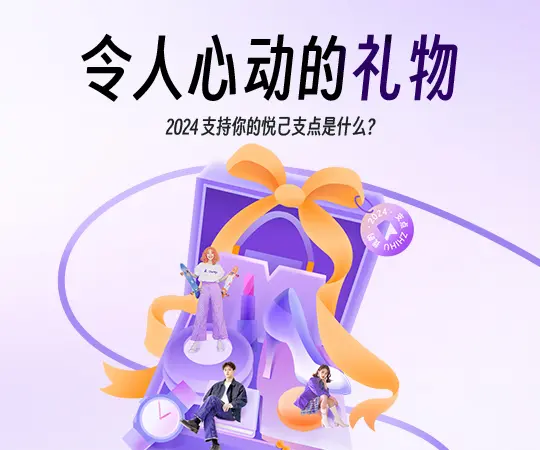Note-taking ability is a person's most fundamental "meta-skill."
An excellent note reflects a person's fundamental way of thinking.
So, good note-taking is about cultivating an "ability to put oneself in another's shoes" through notes, enabling one to truly transition from their current state to another.
Regarding notes, I have a few opinions:
The information resources we are exposed to every day determine our perspective, which in turn influences our decisions and sets the tone for our destiny. Those who are only repeatedly exposed to the same type of information will not have a chance to stand out, or if they do, it is very slim.
Most people spend their entire lives busy with "knee-jerk reactions." People are willing to do anything to avoid real thinking.
The essence of note-taking is the way of thinking. People who are good at solving problems have actually solved them at the initial stage of taking notes.
True knowledge can certainly be transformed into productive power in reality, and then it can form a dimensional reduction strike on real-world problems.- Only what is visualized can be managed.
Look.
All things under heaven are understood when one is idle and detached, and used appropriately when one is busy.
The former is called making light of what is heavy, the latter is called making heavy of what is light.
So, during the relatively calm period, you should perceive some things, understand some things, and prepare some things. Then, when the next cycle begins, they will be useful in the midst of the bustle.
This carrier is notes.
Only by continuously acquiring information, integrating information, analyzing information, filtering information, refining information, and utilizing information can we ultimately form our own unique way of thinking and values, and have the confidence to clearly express our views and influence.
Responding to the world with your own standards and beliefs is itself a very cool thing.
After years of evolution, two main note-taking methods have been accumulated: A symbols and four-color highlighters.
Regarding "A+" notes, the inspiration comes from "Smart People Use Grid Notebooks."
Here, A stands for action (Action), and the sentences that can be converted into actions are marked accordingly. All reading, in the end, should be put into practice, and we “think about problems based on action”.[1]
Therefore, this sentence must be clear and precise, directly actionable, and operational.
Action-oriented thinking allows us to get to the point faster and clarify actions. Thus, having a clear grasp of the situation, we can act decisively.
Has the following syntactic features:
- observable;
- Specificity and particularity;
- It can be broken down into several small steps;
- The first step can be completed within five minutes.
For example, you have a subordinate, and you ask him to "write a summary about something."
So, this is not called thinking about problems based on actions.
Because no matter how hard the subordinate tries to think according to your requirements, no concrete images or next steps for action will form in his mind.
If the request is made like this:
Can you find the three main reasons for Company A's sales increase of 20% compared to last month, write them on an A4 paper, and submit them to me by 12 PM tomorrow?
Such a description makes subordinates immediately understand what they need to do and can take action right away.
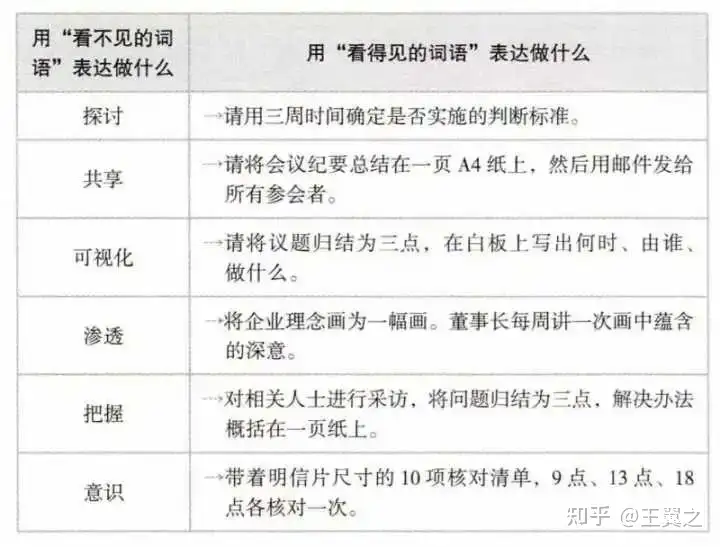
Clear goals can liberate us.
Any time you are in your worst state, it is certainly when you have lost your goal.
We need to live with goals and missions, full of enthusiasm.
Following the 「A+」notes, with the mindset of OKR, I gradually started to try the 「weekly outline」method of governance from October 2019.
Each item in the "Weekly Outline" comes from the "A+" notes.
And, I once specifically listed a goal about the weekly outline:
Adhere to the weekly guidelines and "comprehensive deliberate practice."
Objective: Goal Management: Adherence to Weekly Guidelines and "Comprehensive Deliberate Practice"
KR1:"Deliberate Practice in the Weekly Outline" as the final deliverable for reading, ruminate on 1 article from the WeChat public account.
KR2: Using the 5W+1H syntax (Do what by when where and how many), review past electronic screenshots to form one "deliberate practice" in the "weekly outline."
KR3: Transform 1 weekly guideline with “specific task scenarios”: (Syntax: If-Then)
...)
Here’s an example: When reading the marketing book “Don’t Sell to Me, Tell Me,” the narrative is presented in segments, continuous and linear.
If transformed into a "program", it would be like this ——
1.9 Objective: Build a personal brand with a storytelling mindset
KR1:Identify your clear and specific goals for you and your business. We have already learned that as a business owner, your personal story is closely tied to your brand. Therefore, being clear about why you are doing this, what you are doing, what you stand for, and who can benefit the most from your skills and passion, makes it easier to stay consistent with your brand story.[2]
KR2: Clarify your theme: State it from your perspective. Don't hesitate to be bold. What benefits can you promise to those who choose to work with you? What can you bring to them? What do you believe in? What will you never give up? What is your promise to the world?
KR3: A story about rebirth: Rebirth is a narrative that is highly suitable for marketing. It is a story about the protagonist falling into a low point, reaching the most hopeless depths, and then miraculously coming back to life. The protagonist's struggle provides a point of conflict, and the ultimate overcoming of obstacles, phoenix rising from the ashes, is very inspiring. Any personal story about overcoming difficulties or dark moments is a story of rebirth.
Ultimately, you will find that it is our choices, actions, and deliverables that determine who we are
And you, are nothing more than your weekly deliberate practice list.
Of course, not everything we read can be directly translated into action. Some concepts, when we first encounter them, are difficult to understand and require further digestion.
If the content read cannot be immediately translated into specific actions, but only evokes some feeling, you can write three words next to it — "Understood."
The hard pen version is written like this:
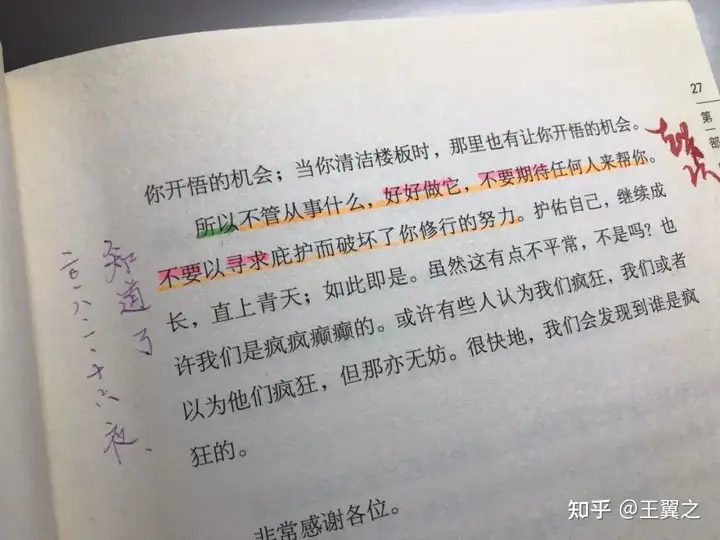
The effect of writing with a brush pen is this style:
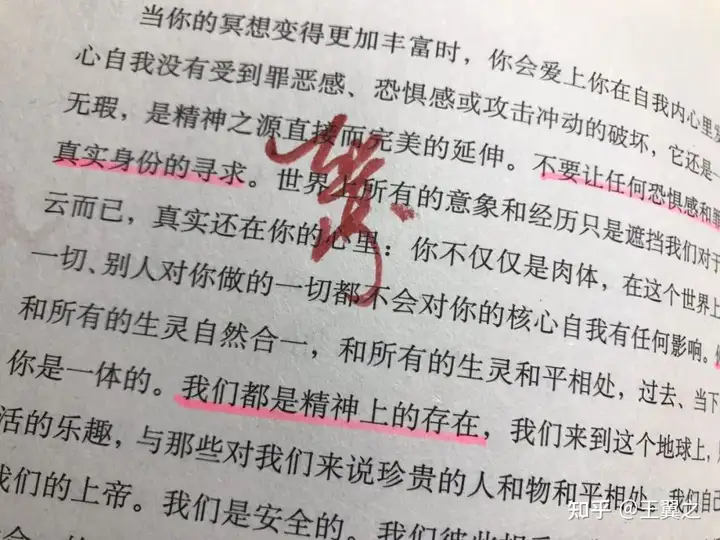
Or something like this:
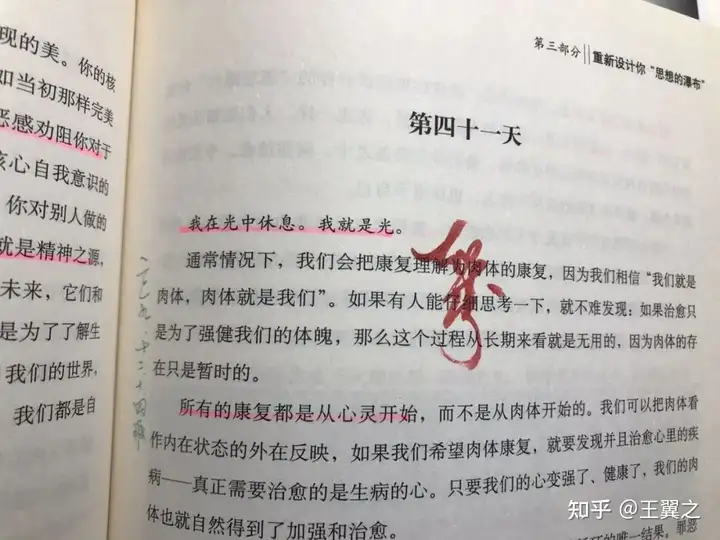
The invention of this "acknowledged" annotation method belongs to the Qing Dynasty emperor.
When they see the ministers' memorials and don't know what to write, they will seriously and perfunctorily write three words —— "acknowledged."
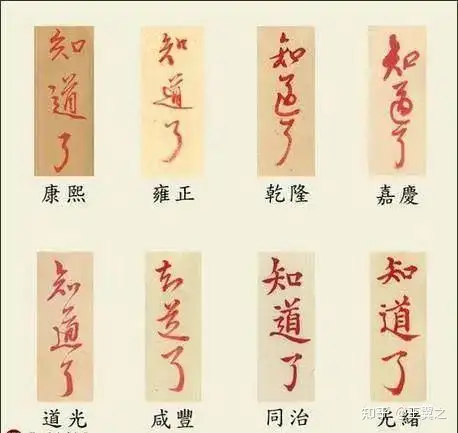
Humans are visual creatures. By assigning different meanings to colors, it is more helpful for categorizing information.
Among various color differentiation methods, Professor Shintaro Saito from Meiji University in Japan proposed the "three-color method," assigning different meanings to the 3 colors red, blue, and green:
In terms of the itinerary, red represents "most important to-do items," blue represents "general to-do items," and green represents "personal matters."
In information management, red indicates "information heard from others" or "more subjective information," blue indicates "secondary information," and green indicates "one's own thoughts."
Everyone may have different definitions of colors, but by establishing personal color usage rules, one can quickly and intuitively identify items of concern when browsing through notes or calendars in the future, greatly improving work efficiency.
For example, I like to use four-color highlighters for annotations.
This idea comes from reading Gui Youguang's five-color circle commentary on the "Records of the Grand Historian" in a 2011 research article.
Marginal comments and annotations, originally a form of literary criticism that developed from the end of the Song Dynasty.
By adding marginal comments, side notes, and interlinear annotations to the text, and using different symbols such as circles, dots, lines, and deletions to leave reading marks.
Regarding Gui Youguang's method, «Gui's Commentary on the Records of the Grand Historian» provides the following explanation for the "five-color circle" symbols:
The beginning of the «Records of the Grand Historian» comes with a fierce momentum; the circles and dots should be made with a gentle touch, but one must see the necessity of circling and dotting. The red circles and dots always indicate the best parts of the meaning and narrative, while the yellow circles and dots always indicate the flow of the text. There are also places where a yellow circle is used for a turn, yet the story continues. Ink marks are used for places that go against reason, blue marks for places that are not crucial, red marks for crucial places, and yellow marks for the most important parts of the text.[3]
The four colors of the highlighters I use for reading are red, green, yellow, and blue. They correspond to two main marking objects, namely “meaningful sentences and narrative benefits” and “qi pulse” cues.
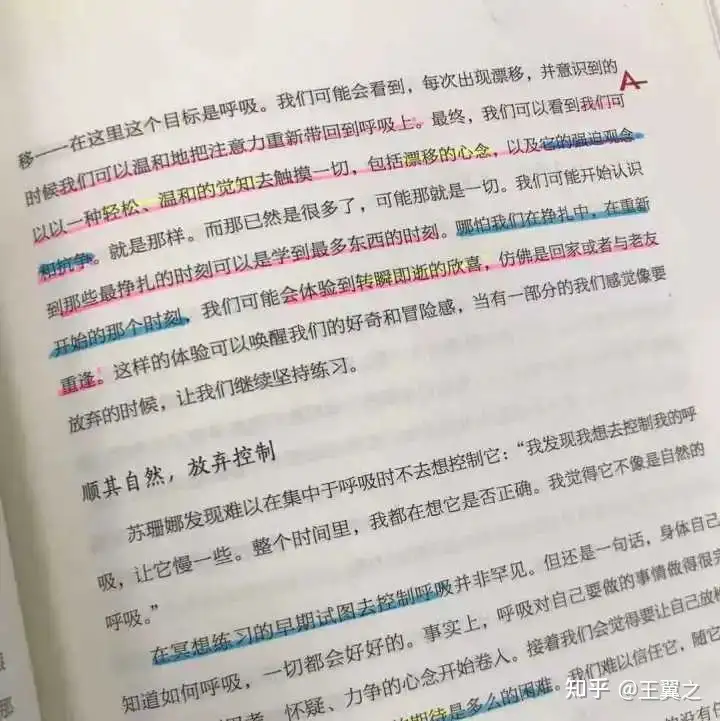
1、red is used to mark the central sentence.
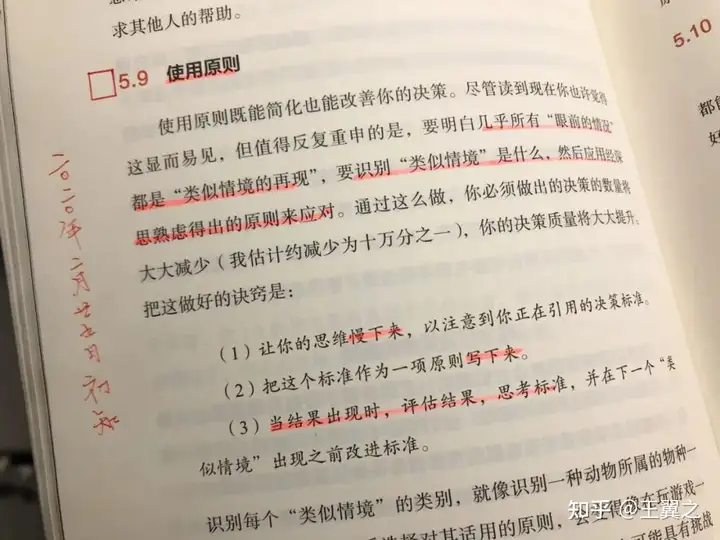
2、green is used to mark “contextual cues,” such as transitions, contrasts, and summaries, which are logical connectives.
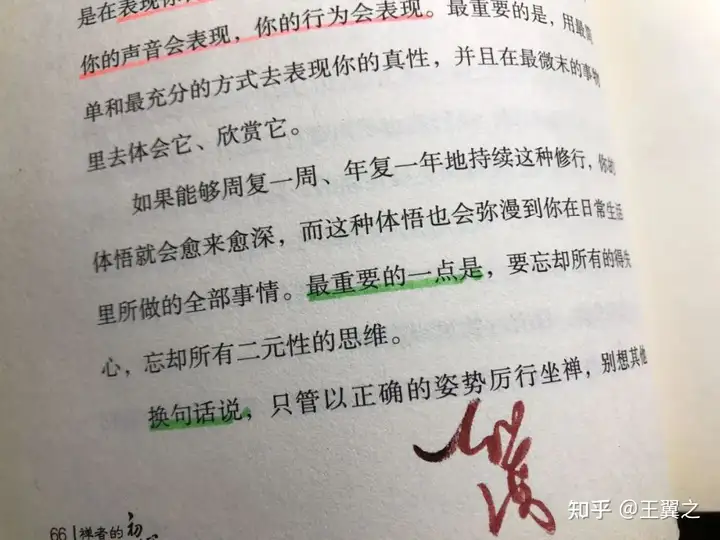
For example: "The key point of this matter is..."; "The conclusion is as follows..."; "This is because..."; "The key points are as follows..."; "Based on these facts..."; "It can be explained as..."; "Such measures need to be taken..."
Through these "landmarks" to understand the writing techniques of “smooth and reverse, positive and negative, hidden and obvious, discontinuous and continuous, open and close, echo and response”.
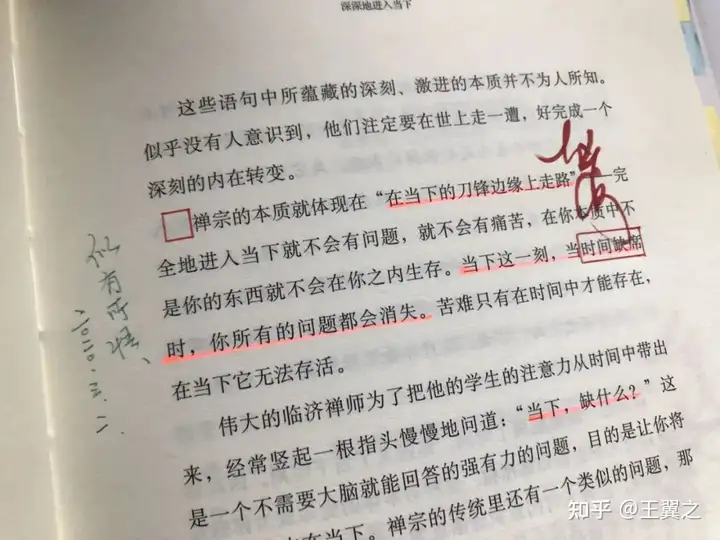
3、yellow is used to record “proper nouns”.
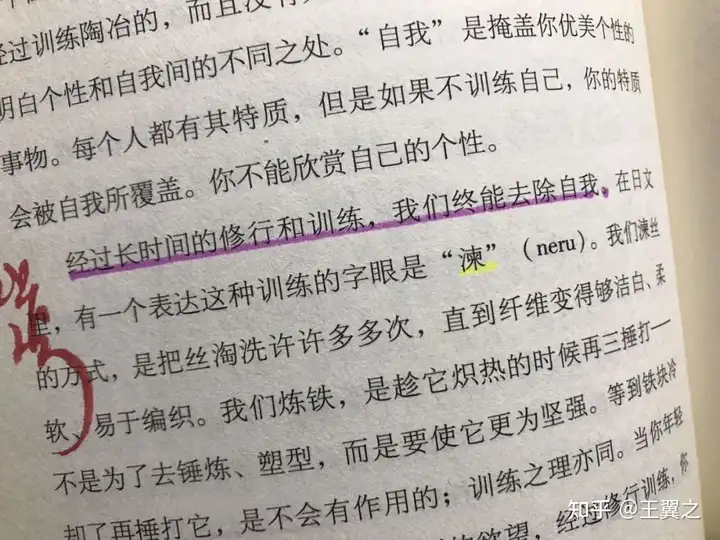
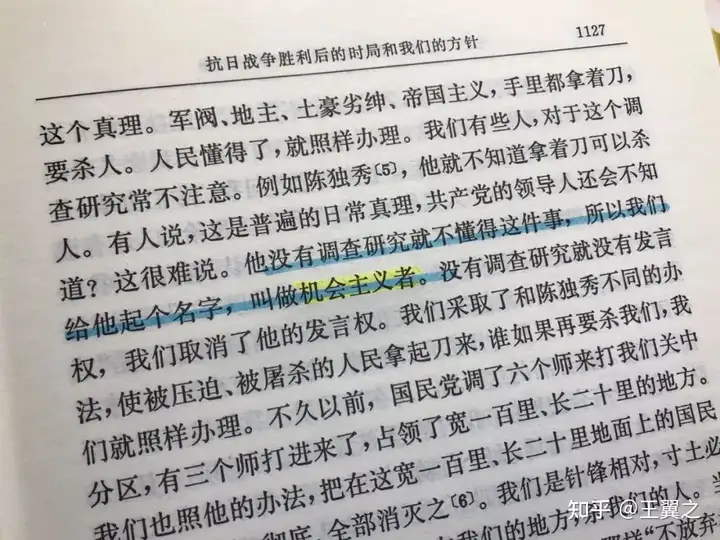
4、blue is used to record counterarguments, which are sentences that negate or contrast.
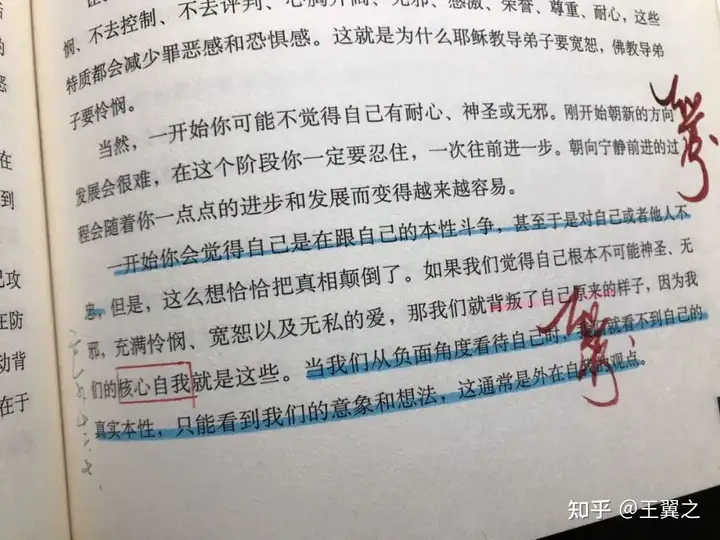
In addition, key words and phrases can be highlighted with boxes.
For example, in Zeng Guofan's 批牍, reading the four characters «deep, steady, clear, and decisive», I can't help but admire them.
Thus, the method is defined as follows:
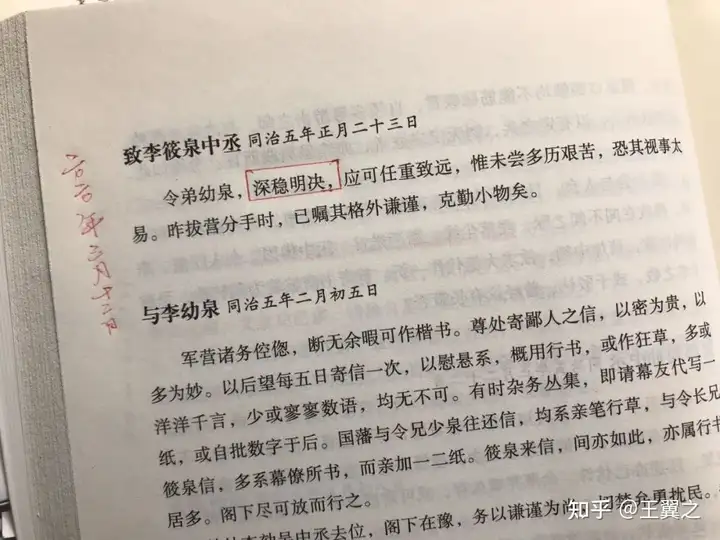
"Reading" books, this commonly accepted practice, is too superficial and one-sided.
So I created a unique Chinese character based on my own note-taking method.
It is written like this:
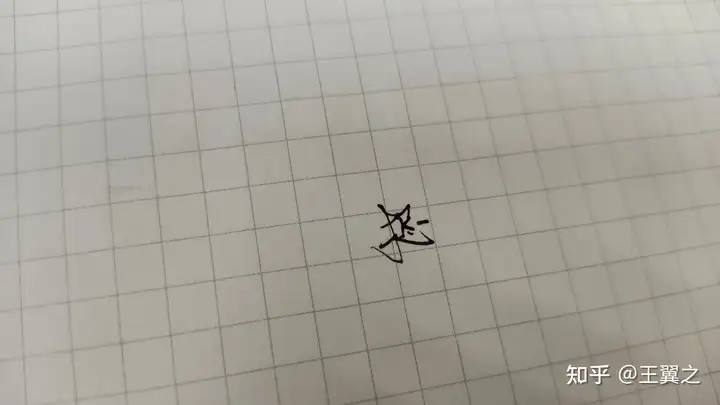
This character is pronounced: tāng (same as 趟).
The process of learning is actually a process of feeling one's way.
So, we don’t read books; we tāng books. Every moment of hesitation, fear of conflict, and inability to refuse is a moment for us to break through our psychological comfort zones and boldly advance towards the “new frontiers” of cognition.
「扌」 means: Taking notes requires the use of hands, and it involves breaking down creative activities into mechanical tasks. Bit by bit, with calloused hands and feet. When others are trying to take shortcuts, your solid and steady work is the best shortcut.
“尺” means: notes require a ruler, searching high and low, moving hands and feet to find things. True extraordinary men are essentially farmers: simple, calm, immersed in their own fields, whether it be music, painting, books, or a player, a mobile phone.
The "heart" below represents: the process of taking notes while reading requires our established beliefs to be challenged. It needs to be a process of deep contemplation where one cannot easily find answers.
A focused and interesting person has a magical power to distort reality, creating their own world that draws you in to appreciate it, bringing you unique and unexpected surprises.
Thinking through notes is just the first step to stepping out of your "comfort zone."
The process of textualization and visualization is also a process of continuous exploration, continuous reasoning, and continuous experimentation.
No one knows what lies ahead, no one gives you clear immediate rewards, no one can give you the meaning of the output. "The vast unknown is uncertain, we do our best, regardless of success or failure."
We should do what we are supposed to do, and leave the rest to fate. This is the attitude we should have when doing things.
Reference
^Smart people use grid notebooks Author: [JP] Masahiko Takahashi Publisher: Hunan Literature and Art Publishing House; Translator: Xiaoya Yuan; Publication Year: 2015-6-1; ISBN: 9787540471644
^Greg Kihn. Don't sell me, tell me (The "Storytelling in Business" Practical Trilogy) (Kindle Locations 526-528). Renmin University of China Press. Kindle Edition.
^ Research on Gui Youguang's Commentary on "The Records of the Grand Historian" - Chinese Literature Research - Issue 2, 2005
Edited on 2023-03-24 09:36・IP Location: Beijing
更多回答
1、阅读笔记,读读写写:
1)最早六七年前,大学因为喜欢阅读。期间保持着,每三天一本书,每本必做笔记的频率。当时印象最深的是,每天夹着书,在图书馆靠窗的位置坐着。沿着感兴趣的话题,读喜欢的书,当时主要思考“红楼梦”和“钱学森之问”。或摘录佳句美文,或写读后感。两年下来,读了几百本书,笔记四五十万字。
具体阅读方法是:先打开目录看→再看一下结尾→接着通读和有重点的阅读→期间,重点摘录,写读后感。于此反复,沿着兴趣的方向→一本又一本→最后再修改、电子化、构成整体。
这样做笔记的好处是,能沿着某一个方向,有重点的推进,而速度很快。
适合于兴趣,如文学、艺术、自然科学等
形式是,摘录与读后感

国家图书馆

大学之时,读读写写,由笔记整理而来
2、备考笔记,自己来重组:
后来进入社会工作,面临着厚厚的专业书,如市政建造师等。因为这个专业,范围广,较枯燥,更着重考察实际经验。如何能在短期内通过考试,这是当时的目标。
为此我采取了:先通读教材一两遍→再用自己的语言、重新组织教材→接着一遍遍手写、理解“自己的教材”→最后,一边总结把书读薄,一边再案例题中寻找感觉。
这样做笔记的好处是,稳扎稳打,加强理解,全面深刻。
适合于备考,如一级建造师、注册会计师等
形式是,有重点的读,并用自己的语言来组织

备考纸质笔记,用自己语言整理编著的一级建造师“教材”

备考电子笔记,用自己语言总结EXCEL版的一级建造师“知识点、关键词”

当时对于备考的计划,重点是理解
3、微软笔记,主力神器:
现在毕业5年,范围更广、思考更深。而只要打开电脑,就会打开微软笔记。微软笔记,又以EXCEL和onenote为主。前者又以表格为主,运用表格文字的方式,迅速、高质量的完成信息的输入、理解。后者又以图片为主,运用图文并茂的方式,形象、系统化的完成信息的输入、再加工等。
1)以onenote做阅读笔记为例,最近在学书法,当学到《解小青楷书教学》的时候。一共30课,每课40分钟,为了加深理解:我会每课截图一张,再用自己的文字再图下标注理解和疑问。当完成这一慕课学习之后,又会通篇复习上述图文,最终整理成数千字的心得。
2)这时就会用到Excel,再把onenote的文字心得,按照认知规律,融入Excel表格中。因为表格的最大特点是,清晰、高效,便于理解。
onenote笔记的强大,在于它的可编辑性、系统性、协同性。可编辑性如,它可以图片转文字等。系统性如,纵向它能向书一页页展开,横向它又能把不同书有序放好。协同性,如它既能很好协调OFFICE办公软件,又能云同步(国外体验更好)等

解小青楷书教学,用onenote同步做笔记

onenote笔记,主要编辑界面之一

EXCEL,它构成了我的笔记世界

10天前更新的“为父母要做的事”,现在看来像是“当代版曾国藩家书”
4、索引笔记,吃透书本:
记得钱钟书读书,他非常喜欢做笔记。他认为只有笔记,才能把书很好的消化和思考。而这种索引笔记,便是阅读学习中的最好方式之一。
我今年学英语的时候,读美剧剧本,时不时会遇到个生词。或者看其他书的时候,总会遇到个把重点难点。对于这些重难点,我通常:先用不同颜色予以标签,再在上面写上关键词,最后附在该页外侧。这样做的好处,如下:
一是清晰简洁,便于建立框架。
二是提纲挈领,快速找到要点。
三是加深理解,吃透整本书。

前不久读的书,索引笔记

还可以当彩笔,突出重点(此为网图)
5、便签笔记,简单高效
前不久我买了很多书,一些心理学、经济学和文学。主要是网购节,当当满减购书。买书的同时,更多的是在思考:如何更有效的读书?
后来我想了一个办法,受手机便签和中学图书馆的启发。用一张/半张A4纸,分左上、右上和下部三部分。左上,记载着书名、归类、作者、出版社等。右上,记录着,购书时间、阅读遍数、来源渠道等等。重点是,下部:有关键词,标记页、收获和不足等。左侧边,还有装订线,以便以后按照日期、类别,来整理存档读书笔记(如下图)。
后来,我每读完一本书,都花半小时,认真去思考和填写。平常读书,这张便签,能作为书签夹在书中。而到一定时候,如每年末,又会统一装订存档等。
这样做笔记的好处是,简单清晰、方便高效、有系统性。
适合于读书,如专业性书籍、文学艺术等
形式是,一张/半张A4纸,用简单的标签格式

整理好的便签笔记

便签笔记,格式如上
6、导图笔记,系统深刻:
现在读书、学课,结束之后,我会静下心来做思维导图笔记。主要为了建立框架,理清思路,了解来龙去脉,更加系统、科学的掌握这门知识。
具体途径,除了网上可参考的各种“导图模式”、“鱼骨头”之外,我更喜欢自己手工制作思维导图:
一般我会选择A3纸、准备好铅笔和原子笔(A4纸过小,铅笔是便于修改)
→接着默默思考,这本书、这个专业,按照知识框架,一步步、用自己的语言、去填充(这步用铅笔)
→再跟着书本、专业,用原子笔在这个框架上修改,这步是为了更加专业和完善
→最后,常读常新,时常总结完善,时常修改这个导图,你会有更深刻的思考
这样做笔记的好处是,你发现:你读的书,学的知识,非常清晰,印象很深,而且系统、科学。
形式是,自己制作思维导图

如图,曾经制作的思维导图笔记,一建市政实务

如图,新颖、实用的鱼骨思维导图(网图,侵删)
7、小工具,让笔记更美好
1)不求甚解的Kindle
4年前,我买了Kindle,因为毕业工作,身边没有足够的书籍阅读。当时买的是日版,因为感到新奇,所以读了很多书,也研究如何记笔记。一时间Kindle中,存了知乎和一些历史书的电子版。一时间电脑中,开始用calibre专门管理这些书。经常睡前半小时,我会拿出来读一会,一边泡脚一边读书。
这种体检相当美妙,一是因为电纸书阅读眼睛很舒服,二是因为这种读书不求甚解心灵开脱。
读kindle的时候,我一般很少记笔记。这如同散步一样,没有特定目标,只是为了生活能足够的养人。

美妙舒服的kindle
2)Everything让笔记更高效
Everything,是一款本地电脑,文件、图片等搜索软件。它的特点是,搜索快速,使用简单。经常我用它来,找笔记中的文件、图片,总能第一时间获取所得的信息。
经常有人问,你平常记了那么多笔记?各种各样,如何忙得过来?其实很简单,掌握一定的方法就可以。比如,电脑中,用Everything快速寻找所需要的笔记。等人等车中,会对一些信息简单的在脑海中处理、存档。处理中,又对大量需要输入加工的信息加入图表形象化等等。
总之,工艺善其事,必先利其器。读书,做笔记,也是如此!

用 Everything快速查找,如这几年关于“微信”笔记
8、笔记之前,学会阅读更重要:
有的书,需要多读几遍,先不急着做笔记。
有的书,需要紧密联系实际,才能更有效的做笔记
有的书,偏于理解,适合在上午思维活跃的阅读
有的书,偏于记忆,适合在临睡、早起的时候阅读
.......
我们读书做笔记,为围绕着“读懂、实践”而来。所以不能轻易下笔,不能只看笔记的形式。
更重要的是,先弄清楚为什么阅读此书?怎样去阅读此书?同时,在实践中提高解决问题和分析问题的能力。

笔记之前,先弄清如何去读
9、思考,如何做好读书笔记?
学习没有固定的方法,读书笔记也是如此。但我们仍能从中,总结和提炼出,一些普遍、高效的笔记方法。它可以是,如下:
1、保持专注。专注生智慧,要想深入思考,做好笔记,这必须具备一定的专注。比如注意力高度集中,利用番茄钟(Forest)保持对信息的专注思考,可以是45分钟,或者更长、更短。
2、贵在坚持。做笔记不是一天两天的事,做好笔记更要持之以恒。今天记一点,明天记一点。不在于量,而在于思考,着重对整体和方法上的不断优化。就像盖房子一样,我们记笔记贵在持之以恒,不断进步,获得质变
3、适合自己最重要。谈了这么多笔记方法,核心是适合自己。可以是安静的图书馆,喧闹的咖啡厅。可以是晨光初露的早上,可以是灯火阑珊的夜里。可以是精致用心的手写,可以是高效方便的电子版等等。
总之,读书和笔记没有固定的方法,适合自己最重要。

找到适合你自己的笔记方法
今年,同事送了一个很萌的刘看山手账本(此处不是广告)给我。我暗下决心要多读书,在本子上做满读书笔记,用以回报「送本之恩」。
然而,我以往都没有做读书笔记的习惯啊(在书上涂涂画画倒是擅长)!
机智的我决定找找相关的书,学习相关经验。就是这样,我去读了《如何有效阅读一本书——超实用笔记读书法》(奥野宣之 著)。这本书让我克服了很多记读书笔记的障碍,能够以轻松愉悦的心情让笔记开始做起来!
结合书中的要点和题主的问题,我主要回答以下两方面的问题吧。
一、如何做笔记
1. 做笔记的原则
(1)「一元化」原则。将笔记和资料存放在同一个笔记本里。在这个笔记本可以书写任何内容,按照时间顺序从前往后书写就行。
我想很多人都有这样的情况(包括我):有了一个心爱的记事本,然后许下要好好记录的愿望,并且在书写时非常慎重——字要写得好看、格式要统一、记录时间要连贯。
作者认为,笔记本里不需要分区、也不需要分类、连写法和空间都不需要区分。想写就写。不想写的时候可以连续几天不写。放松下来,附好日期就好啦。
(2)「坚持下去」原则。做好读书笔记以「坚持下去」为先。能否得心应手地做好读书笔记,进而熟练参考记录过的笔记,都需要坚持下去。
(3)「自己能力允许」原则。这其实是为了让自己能够「坚持下去」,因为只有把读书笔记控制在自己能力允许的范围内,才能更久地坚持下去。所以要选择对自己来说比较方便的笔记方法。
可以以最简单的方式记笔记。例如:
「×× 年 × 月 × 日,我读了《× × × ×》。这本书很有意思。」
总的来说,一心想要写得完美,只会让自己越来越难下笔。先保持轻松的心态,开始记录吧~
2. 怎么记读书笔记
- 启动「筛选程序」来帮助自己记笔记,具体方法如下:

以前我以为阅读笔记都是一边读一边记录。在具体的实践中,这样的方法避免了我阅读的中断,能够保持阅读的流畅感。通过通读和重读,也能够更好地判断哪些才是真正摘抄的重点。
- 读书笔记要记录哪些内容
作者提出了笔记的五个要素:

看起来很复杂,但不要紧张。依据前面说到的「坚持下去」和「自己能力允许」原则,如果之前没有做读书笔记的习惯,可以先只记录前三个要素!
(4)(5)实际上是进阶选项,可以让读书体验更加深刻。摘抄用「○」表示,自己的评论用「☆」表示(如果你有其他更喜欢的符号也是可以啦)。
以我阅读《面试加分项》为例,笔记可以这样记录:

关于「记录感想」,再多说一句。一定要记录对自己重要的事!
不要拼命思考作者要传达什么,也不要在意别人对书的评价,只需要整理自己的想法和心声,即使只是简单地想要记录「这个人真厉害」也是没问题的。
二、什么时候重读读书记录
1. 形成规律。
寻找固定的场景去重读,例如睡前或是洗完澡后,也可以安排好重读时间,确定重读频率,例如一周一次或三天一次。
如果不想特意去限定每次重读的时间,规定自己「笔记本用完后」一定要重读也是一个很好的方法。
2. 想要简单回顾时查看读书笔记。想要回忆更多时,查看书中的重点段落。想从头开始看时,重读原书。
最后,
培养做读书笔记的习惯并不是一件轻松的事。在开始做的时候一定不要太要求完美,否则反倒会有抵触心态。
找到自己方便的方式,保持轻松的心态,「随意」地记录起来吧!
注:本回答的提供的方法来自《如何有效阅读一本书——超实用笔记读书法》(奥野宣之 著)。
有知友在评论里推荐《如何阅读一本书》,这本书的书摘我也有分享哟~欢迎大家前往专栏阅读。
Qian Mu Yiyang also followed him
How to take good reading notes?3 answers
How to take good reading notes?3 answers
